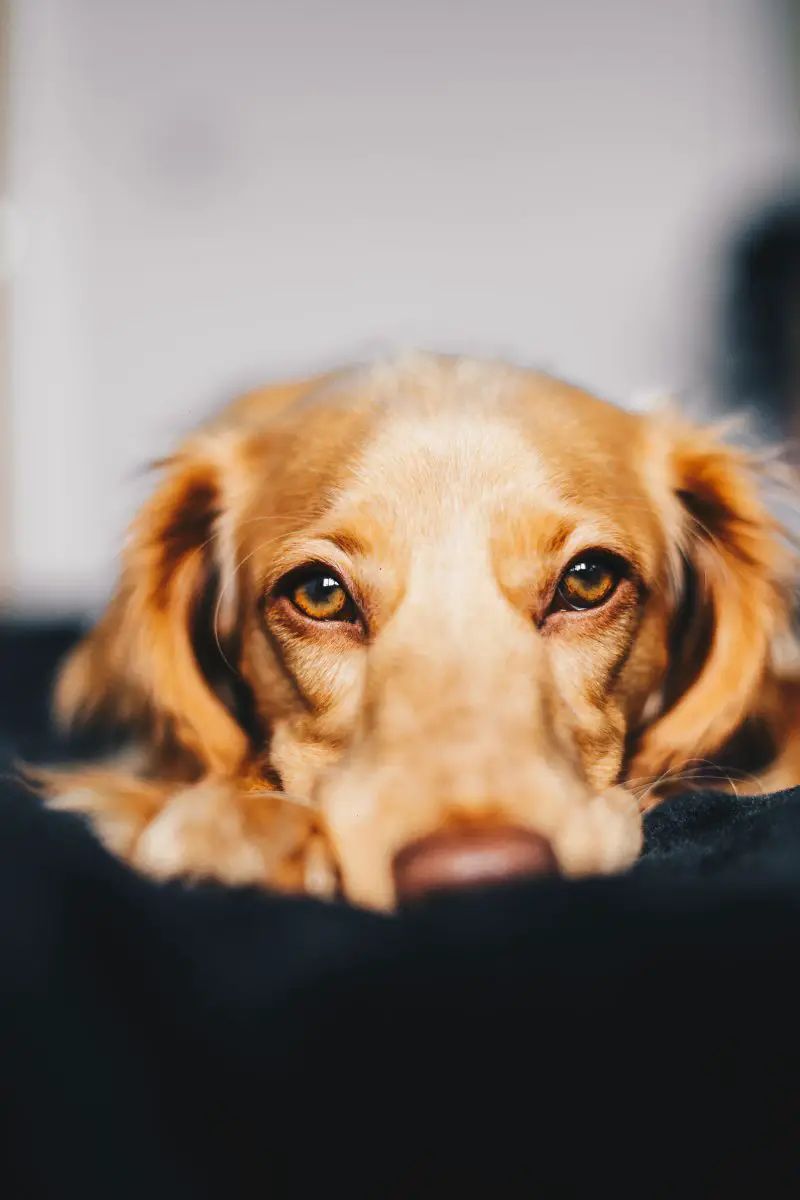Wenn Sie oder ein geliebter Mensch eine Schnittwunde haben oder unter Hautirritationen oder Schmerzen leiden, können Sie nach Bactine in Ihrem Medikamentenschrank greifen. Wenn Sie bemerken, dass Ihr Hund einen Kratzer oder eine Hautreizung hat, ist die Frage „Kann ich Bactine bei meinem Hund anwenden?“ eine völlig logische Frage. Kann man also einen Hund mit Bactine besprühen? Ist dieses menschliche Antiseptikum für unsere Hundebegleiter sicher oder stellt es eine Gefahr für ihre Gesundheit dar? Erfahren Sie mehr über Bactine und ob die Anwendung bei Hunden sicher und wirksam ist.

Inhaltsverzeichnis
- Kann ich Bactine bei meinem Hund anwenden?
- Wofür wird Bactine bei Hunden verwendet?
- Bactine bei Hunden: Dosierung und Häufigkeit
- Können Sie Bactine an den Hot Spots eines Hundes anwenden?
- Mögliche Risiken der Verwendung von Bactine bei Hunden
- Kleine Hundeverletzungen zu Hause behandeln
- Wann Sie Ihren Hund zum Tierarzt bringen sollten
- Bactine Alternativen
- Bactine auf Hundewunden – Schlusswort
- Häufig gestellte Fragen
Kann ich Bactine bei meinem Hund anwenden?
Können Sie also Bactine bei Hunden anwenden und ist Bactine sicher für Hunde? Ja, bei richtiger Anwendung und in den richtigen Situationen kann Bactine sicher bei Hunden angewendet werden.
Sie können Bactine auf kleinere Verletzungen wie Schnitte, Kratzer und Kratzer auftragen, um sie sauber zu halten und Infektionen vorzubeugen.
Wofür wird Bactine bei Hunden verwendet?
Bevor Sie fragen: „Darf ich Bactine auf meinen Hund sprühen“, ist es wichtig zu verstehen, wofür Bactine verwendet wird. Dies kann Ihnen helfen festzustellen, ob Bactine angesichts der Art der erlittenen Verletzung überhaupt eine geeignete Behandlungsoption für Ihren Welpen ist.
Bactine ist ein Antiseptikum, das rezeptfrei erhältlich ist. Es ist hauptsächlich für den menschlichen Gebrauch bestimmt, um kleinere Verletzungen zu behandeln und Infektionen vorzubeugen. Die beiden Wirkstoffe in Bactine sind Benzalkoniumchlorid (BAC) 0,13% und Lidocain HCL 2.5%.
BAC ist ein Antiseptikum, das Bakterien abtötet und die Heilung der obersten Hautschicht unterstützt. Lidocain ist auch in der Formel von Bactine enthalten, da es ein topisches Anästhetikum ist, das den Wundbereich betäubt und hilft, Schmerzen zu lindern.
Bactine ist nicht zur Behandlung großer Schnitte oder Wunden gedacht, sondern sollte nur in kleinen Bereichen verwendet werden.
Bei der Anwendung an einem Hund gelten dieselben Regeln; Bactine ist nicht zur Behandlung großer Wunden geeignet. Verwenden Sie Bactine nur, um kleinere Schnitte, Kratzer, Verbrennungen oder Schürfwunden an Ihrem Hund zu behandeln.
Die Verwendung von Bactine bei einem Hund kann Ihnen helfen, eine Wunde oder Verletzung zu desinfizieren, die der Hund erlitten hat. Einige der anderen Möglichkeiten, wie Sie Bactine bei Hunden anwenden können, umfassen die Behandlung von Insektenstichen, Hefeinfektionen, Staphylokokkeninfektionen, Hot Spots, Hautausschlägen, Giftefeu und abgenutzten Ballen an den Pfoten.
Sie sollten nicht nach Bactine greifen, wenn Ihr Hund eine sehr tiefe Wunde oder einen großen Schnitt hat. Bactine reicht nicht aus, um diese Art von Wunden zu behandeln, und Sie sollten Ihren Hund stattdessen zur Behandlung zum Tierarzt bringen.

Bactin bei Hunden: Dosierung und Häufigkeit
Im Gegensatz zu anderen Medikamenten, die einem strengen Dosierungsplan folgen müssen, ist die Anwendung von Bactine etwas flexibler. Verwenden Sie es nach Bedarf, abhängig von den Wunden Ihres Hundes. Viele Experten empfehlen, Bactine etwa 10 bis 14 Tage lang ein- oder zweimal täglich auf die betroffene Hautstelle Ihres Hundes aufzutragen. Sie müssen den Wundbereich beobachten, um die Heilung zu beurteilen und sicherzustellen, dass das Bactine keine negativen Nebenwirkungen verursacht, um genau zu bestimmen, wie lange Sie es weiter verwenden sollten.
Denken Sie daran, dass Bactine nicht für große oder tiefe Wunden geeignet ist. Wenn Ihr Hund eine solche Wunde hat, suchen Sie sofort einen Tierarzt auf.
Denken Sie auch daran, dass Bactine ein topisches Medikament ist. Es sollte niemals von Ihrem Hund verzehrt werden.
Können Sie Bactine an den Hot Spots eines Hundes anwenden?
Ja, Sie können Bactine auch für Hot Spots bei Hunden verwenden.
Falls Sie nicht damit vertraut sind Hot Spots bei einem Hund, sie sind eine Hauterkrankung, die am häufigsten an den Hüften, Beinen und am Kopf auftritt. Hot Spots sind das Ergebnis von Hunden, die so häufig und mit so viel Kraft an ihrer Haut kratzen, dass sie die Haut brechen und eine offene Wunde hinterlassen. Allergien und Lebensmittelunverträglichkeiten sind eine häufige Ursache für Hot Spots. Ohrinfektionen, übermäßiges Lecken, zu viel Feuchtigkeit nach dem Schwimmen und verschiedene andere Probleme können ebenfalls zu heißen Stellen führen.
Wie Sie vielleicht erraten haben, können Hot Spots für einen Hund sehr unangenehm sein. Sie können sowohl jucken als auch schmerzhaft sein, daher ist es wichtig, Ihrem Hund dabei zu helfen, Erleichterung zu finden. Sie müssen mit Ihrem Tierarzt zusammenarbeiten, um das Problem zu finden und zu beheben, das die Hot Spots verursacht. Die Verwendung von Bactine während dieses Prozesses kann jedoch hilfreich sein. Das Bactin hilft der Haut bei der Heilung und verhindert, dass der Bereich infiziert wird.
Darüber hinaus ist einer der Wirkstoffe in Bactine, wie wir oben erwähnt haben, Lidocain. Das Lidocain sorgt dafür, dass sich der Hautbereich des Hundes taub anfühlt und lindert so die Schmerzen und Reizungen, die Ihr Hund verspürt.
Mögliche Risiken der Verwendung von Bactine bei Hunden
Die Antwort auf die Frage „Können Sie Bactine bei einem Hund anwenden“ lautet „Ja“, es gibt jedoch dennoch einige Vorsichtsmaßnahmen und Risiken, die Sie beachten sollten.
Zunächst müssen Sie sicherstellen, dass Ihr Hund kein Bactine konsumiert. Einer der Wirkstoffe, Benzalkoniumchlorid (BAC), kann beim Verschlucken gesundheitsschädlich sein.
Natürlich werden Sie Ihrem Hund das Bactin nicht absichtlich mit dem Löffel verfüttern, aber das ist nicht die einzige Möglichkeit, wie er das BAC aufnehmen kann. Viele Hunde jucken oder beißen in Wunden oder Hautausschläge, um den Schmerz oder den Juckreiz zu lindern. Wenn sie das Bactin auflecken, gelangt es in ihren Körper und kann negative Nebenwirkungen verursachen. Einige mögliche Nebenwirkungen sind:
- Gewebeschaden
- Wunden auf der Zunge/im Mund
- Erbrechen
- Verminderter Appetit
- Mehr sabbern als normal
- Fieber
- Geschwächte Muskeln
Auch der andere Wirkstoff in Bactine, Lidocain, kann bei der Einnahme durch einen Hund zu negativen Nebenwirkungen führen. Denken Sie daran, dass Lidocain eine Wunde betäubt. Wenn es verschluckt wird, kann es den Hals und das Maul eines Hundes betäuben, was zu Schluckbeschwerden und einem erhöhten Risiko für das Ersticken führen kann.
Lidocain kann auch giftig sein, wenn ein Hund große Mengen davon verschluckt (über 10 mg pro Pfund Körpergewicht). Damit Ihr Hund giftig ist, müsste er viel Lidocain zu sich nehmen, weit mehr, als Sie auf eine Wunde auftragen würden. Wenn Sie befürchten, dass Ihr Hund es irgendwie geschafft hat, so viel Bactin aufzunehmen, dass er von einer Lidocain-Toxizität bedroht ist, können Sie auf folgende Symptome achten:
- Anfälle
- Durchfall
- Erbrechen
- Verlust der Koordination
- Ermüdung
- Zittern
Wie Sie sehen können, treten die meisten potenziellen negativen Nebenwirkungen der Verwendung von Bactine bei Ihrem Hund auf, wenn Ihr Welpe das Antiseptikum einnimmt. Wenn Sie Bactine verwenden möchten, ziehen Sie in Betracht, Ihrem Welpen ein elisabethanisches Halsband, auch als E-Halsband oder Kegel bezeichnet, anzulegen. Diese Halsbänder verhindern, dass Hunde sich selbst lecken oder beißen können. Die Verwendung eines E-Halsbands kann auch dazu beitragen, den gesamten Heilungsprozess zu beschleunigen.
Eine letzte Sache, die Sie bedenken sollten, bevor Sie Bactine bei Ihrem Hund anwenden, ist, dass es brennen kann. Wenn Sie Bactine jemals auf einer offenen Wunde angewendet haben, kennen Sie das Gefühl. Seien Sie darauf vorbereitet, dass Ihr Hund jault oder sich aufregt, wenn Sie Bactine auf seine Wunde auftragen. Erwägen Sie, ein Leckerli bereitzuhalten oder ihm gleich nach dem Auftragen ein wenig mehr Liebe zu schenken, damit er sich etwas besser fühlt.
Kleine Hundeverletzungen zu Hause behandeln
Nachdem Sie nun wissen, dass die Antwort auf die Frage „Kann man einem Hund Bactine verabreichen“ „Ja“ lautet, besteht der nächste Schritt darin, zu lernen, wie man sich um seinen Hund kümmert, wenn er eine leichte Verletzung hat. Das Auftragen von Bactine auf eine Wunde ist nur ein Schritt im Prozess der Pflege Ihres Hundes, der Vorbeugung von Infektionen und der möglichst schnellen Wundheilung.
Denken Sie daran, dass die Schritte, die wir Ihnen mitteilen werden, nur für kleinere Wunden gelten; Wenn Ihr Hund einen extrem tiefen oder großen Schnitt oder eine Platzwunde hat, versuchen Sie nicht, ihn selbst zu behandeln. Größere Wunden können sehr schwerwiegend sein und erfordern eine tierärztliche Behandlung.
Bevor Sie mit der Behandlung der kleinen Schnittwunde Ihres Hundes beginnen, sollten Sie darüber nachdenken, Ihrem Hund einen Maulkorb anzulegen. Das mag etwas grausam erscheinen, ist aber eine gute Maßnahme, um sich und Ihren Welpen zu schützen. Der Schmerz einer Wunde und der Stress, den Sie beim Versuch haben, sie zu behandeln, können für einen Hund großen Stress verursachen. Wenn Ihr Hund gestresst und ängstlich ist, ist die Wahrscheinlichkeit größer, dass er versucht, zu beißen.
Sobald Ihr Hund bereit ist, befolgen Sie die folgenden Schritte, um seine Verletzung zu behandeln:
- Trimme vorsichtig jegliches Fell um die Wunde herum. Dies wird dazu beitragen, dass Sie klar sehen können, wo Sie arbeiten, und die Schwere des Schnitts bestätigen.
- Verwenden Sie ein warmes, feuchtes Tuch, um den Bereich von Blut, Schmutz oder anderen Ablagerungen zu reinigen.
- Desinfizieren Sie den Schnitt mit einem Povidon-Jod-Produkt wie Betadine.
- Sobald die Wunde getrocknet ist, sprühen Sie Bactine darüber.
- Lassen Sie die Wunde erneut trocknen und wickeln Sie die Stelle anschließend vorsichtig mit einem Verband ab. Abhängig von der Größe und Lage der Wunde kann ein Schmetterlingsverband gut funktionieren. Achten Sie darauf, den Verband nicht zu fest anzulegen, da dies die Durchblutung verringert und die schnelle Wundheilung beeinträchtigt.
- Legen Sie Ihrem Hund ein elisabethanisches Halsband an. Dadurch wird sichergestellt, dass Ihr Hund nicht an der Wunde leckt. Das Lecken der Wunde könnte dazu führen, dass Ihr Hund Bactin aufnimmt, was möglicherweise negative Nebenwirkungen zur Folge haben könnte. Darüber hinaus kann das Lecken der Wunde dazu führen, dass die Heilung länger dauert.
Wann Sie Ihren Hund zum Tierarzt bringen sollten
Während es viele Verletzungen gibt, die Sie zu Hause behandeln können, ist es auch wichtig zu verstehen, wann es Zeit ist, Ihren Hund zum Tierarzt zu bringen und ihn von einem Fachmann pflegen zu lassen. Tierärzte sind bestens ausgebildet und erfahren im Umgang mit Wunden an Tieren. Wenn Sie also jemals Fragen dazu haben, ob Sie sich um Ihren Welpen kümmern können oder nicht, gehen Sie auf Nummer sicher und vereinbaren Sie einen Termin mit Ihrem Tierarzt.
Es gibt auch Zeiten, in denen Sie die häusliche Pflege Ihres Hundes komplett überspringen und ihn direkt zum Tierarzt bringen sollten. Diese schließen ein:
- Sehr große oder tiefe Wunden
- Verletzungen an empfindlicheren Körperstellen
- Wunden, die rot, geschwollen, mit Eiter gefüllt oder anderweitig eindeutig infiziert sind
- Wunden, die nicht aufhören zu bluten

Bactine Alternativen
Wenn Ihr Hund eine Wunde hat und Sie kein Bactine zur Hand haben, können Sie auch einige Alternativen ausprobieren. Diese beinhalten:
- Oreganoöl (verdünnt):Oreganoöl Wirkt antiviral, antibakteriell, antimykotisch und antiparasitär und ist somit eine gute Ergänzung für jedes Erste-Hilfe-Set für Hunde. Um Oreganoöl auf die Wunde eines Hundes anzuwenden, mischen Sie einen Tropfen mit Mandelöl und tragen Sie es auf die Wunde auf. Beachten Sie, dass Sie kein Oreganoöl verwenden sollten, wenn Ihr Hund unter Krampfanfällen leidet.
- Manuka-Honig:Manuka-Honig, das aus dem Manuka-Baum stammt, wirkt auch als Antiseptikum zur Wundreinigung. Um Manuka-Honig bei Ihrem Hund anzuwenden, tragen Sie ihn als topische Salbe auf die betroffene Stelle auf.
- Kolloidales Silber:Kolloidales Silber ist ungiftig und somit sicher für die Anwendung bei Hunden geeignet. Es hat außerdem keinen Geruch oder Geschmack, weitere Eigenschaften, die es zu einer guten Wahl für Haustiere machen. Kolloidales Silber besteht aus einer flüssigen Basis und winzigen Silberpartikeln. Das Silber tötet Bakterien und Viren ab und eignet sich daher gut zur topischen Behandlung von Wunden, heißen Stellen und Verbrennungen.
- Desinfektionsmittel:Es ist wichtig, in Ihrem Erste-Hilfe-Kasten Desinfektionsmittel zu haben, die für Hunde geeignet sind. Povidon-Jod ist eine gute Option für unsere Hundefreunde. Bevor Sie ein Desinfektionsmittel verwenden, sollten Sie es verdünnen, um eine Schädigung des Hautgewebes zu vermeiden.
Bactine auf Hundewunden – Schlusswort
Kann ich meinem Hund Bactine verabreichen, ist eine Frage, die sich viele Tierhalter stellen. Wie bereits erwähnt, ist Bactine ein im Allgemeinen sicheres Produkt, wenn Sie versuchen, eine kleinere Wunde bei Ihrem Hund zu behandeln. Es gehört zu Ihrem Job, sich Sorgen um Ihren Hund zu machen. aber hoffentlich sind Sie nicht immer noch besorgt darüber, wie Sie ihnen die bestmögliche Pflege bieten können.
Häufig gestellte Fragen
Zu den für Hunde sicheren Antiseptika gehören Bactine, Bacitracin und Polymyxin B. In manchen Fällen kann Ihr Tierarzt auch andere Antiseptika verschreiben, die speziell für den veterinärmedizinischen Gebrauch entwickelt wurden.
Jawohl, Bacitracin ist sicher für die Anwendung bei Hunden.
Viele antiseptische Sprays für den Menschen sind für Hunde nicht sicher. Beispielsweise sind Savlon, Dettol und Neosporin für Haustiere nicht sicher. Einige Antiseptika für den Menschen, wie Bactine und Bacitracin, sind für die Anwendung bei Hunden unbedenklich. Wenn Sie sich nicht sicher sind, ob ein bestimmtes Antiseptikum oder Medikament für Ihren Hund sicher ist, fragen Sie Ihren Tierarzt.





